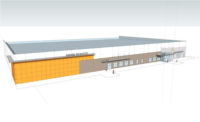Initially, Dan Abel didn’t envision overseeing a plant turning out 500 different types of confections and servicing nine retail shops, hundreds of wholesale accounts and several private-label and contract manufacturing agreements.
After all, the man who in the early 1980s spent two years working seven days a week at Gorant Candies in Ohio just to hone his candy making skills, simply wanted to return to St. Louis to start his own chocolate business.
“I opened up my first store in 1981,” he recalls. “We had a small Hillard’s enrober and a small window at the back of the store where you could watch the candy being made. And I was paying 22% interest on my loan.”
Fast forward 31 years and Abel’s doing much more than just enrobing at his company, Chocolate, Chocolate, Chocolate — although he still does so using a newly installed 100-ft. Hillard’s line, the largest that company’s ever made.
Today, Abel, together with his wife, Rosalie, and their three children, Christina, Dan Jr. and Chris, manage a sophisticated confectionery operation that integrates retailing, wholesaling and contract manufacturing under one 30,000-sq.-ft. headquarters and production facility.
Not an “overnight” success story by any means, Abel’s gradual but continuous growth did receive a boost nonetheless when his children began to enter the business professionally.
Of course, as with nearly every family business, the youngsters had been involved from an early age. As Rosalie points out, from the time the tykes could walk, the family would head out on Sundays to St. Louis’ central produce market to pick up strawberries for enrobing. Not quite the Sunday outing most children typically experience, but one that allowed them to eat strawberries in the car as they drove the fruit back to the shop, Abel says. Moreover, as he explains, “Chocolate-dipped strawberries were a big part of our business.”
For Christina, Dan Jr. and Chris, growing up with parents who ran chocolate retail shops meant helping out whenever and whatever.
“My mother and wife would dress up in chicken and bunny outfits,” Abel says, underscoring the whatever.
Each child’s involvement during school and subsequent graduation from college has made a significant impact on the business, helping Abel and Rosalie to successfully manage the company’s evolution into new markets.
For example, Christina — who was still studying at Bentley University in Waltham, Mass. at the time — hammered out a new franchise agreement with her father in 2002. The revised franchising contract proved instrumental in opening up new retail sites for Chocolate, Chocolate, Chocolate Co. (CCC).
“We have a total of nine stores, three of which we own that are also franchisees,” explains Abel. “By having our stores part of the franchisee system, we have a level playing field. Since they are our oldest stores [largest revenue generators], they contribute to the advertising fund. In addition, it helps the whole system, since everything we require from our franchisees to do, we also have to comply. In the end, we want everyone to succeed.”
Upon graduating college in 2005, Christina, together with Dan Jr. who was pitching in as always during the summer, quickly made an impact in helping grow the company’s wholesale business.
As Dan Jr. relates, senior Abel quickly make it clear that hiring on family members didn’t translate into resting on one’s laurels. “As he told us, ‘I make my paycheck. Now that you’re joining the business, you have to find a way to grow it.’”
And grow it they did. Christina quickly put together a list of every tourist attraction in the St. Louis area and she and Dan Jr. began the process of cold calling to set up appointments. Be it the Gateway Arch, the History Museum, the Botanical Gardens or the Lambert - St. Louis airport, all of them agreed to carry CCC products.
“We hit it big that first summer on getting new accounts, but we knew we would be successful once those second orders would come in,” Dan Jr. says. It didn’t take long before those second and third orders started flowing in, ensuring continued development of wholesale accounts.
From then on, a series of events propelled the company into several different directions, all instrumental in triggering the Abel family’s decision to purchase a new manufacturing and headquarters site.
In early Oct. 2009, the company acquired Lake Forest Confections from Bud Kolbrener, former owner of Bissinger’s Chocolates in St. Louis and ultimate chocolate philanthropist. Upon selling Bissinger’s in 1995, Kolbrener looked forward to enjoying his retirement. However, he found himself back in the chocolate business when he opted to help several former Bissinger’s employees find work. He did so by opening up another chocolate shop, Lake Forest Confections in 2004.
Intent on handing over the business to employees after training them, Kolbrener found himself still actively involved for the next five years — a result of employees reluctant to take charge.
In seeking a buyer for the business who would promise to keep the existing staff, Kolbrener found Abel, who recognized an opportunity to not only acquire a new production facility, but experienced help as well.
“When Bud opened up Lake Forest Confections, he did so with the idea of creating a small French chocolate shop,” Abel says. “He also built a beautiful kitchen, far larger than our own and with much more capacity for production than just for one store.”
Recognizing a kinship for quality product as well as valuing a master chocolatier and entrepreneur capable of not only creating European truffles but fixing enrobing machines and cooling units, Abel convinced Kolbrener to stay on as a consultant.
“He comes and goes whenever he wants to, but most of the time, he’s here,” the CCC patriarch says. “He’s really a member of our management team, part of the family.”
The acquisition of Lake Forest Confections prompted the company to move all production, most of which was occurring at the company’s Chippewa St. store, to the Lake Forest site.
Shortly after that decision in March 2010, the Abels were contacted by “friends in the industry” to produce a retailer’s entire line of boxed chocolate. Dan Jr., who had joined the company full-time in 2008, emphasizes that this company operated several high-volume chocolate stores. It was time to roll up the sleeves.
Coincidentally, just a few months earlier, the Abels had decided to resurrect a well-known St. Louis confectionery brand, Mavrakos. The famed chocolate retail chain, which dates back to 1913, was sold to Archibald Candy Co. in 1984.
“Tom Wotka, the owner of Mavrakos then, sold 18 stores to Archibald,” Abel says. “I purchased one store from him. I also received all his recipes. They had been sitting in my desk for 15 years.”
The return of Mavrakos chocolates in October 2009 set into motion a nostalgic sales surge for the company, creating yet another wholesale revenue stream. It also paved the way for one of the “most difficult Christmases in the company’s history,” says Dan Jr.
The continued success of the Mavrakos brand, coupled with ongoing growth in contract manufacturing and the addition of a new corporate account from one of the largest companies in St. Louis, pushed production to its limits.
“We were working 12- to 13-hour days, running the line after our workers left for another two hours as well as packing the product into boxes for shipment the next day,” Dan Jr. says.
Even though all production now occurred in the Lake Forest Confections facility, product still had to be shipped to the Chippewa St. store for distribution to various franchises and accounts.
Having survived a wonderful, but simultaneously exhausting, Christmas season, the discussion at the family table turned toward improving the company’s ability to service all its customers more efficiently and sanely.
The idea of having a spacious central manufacturing facility no longer seemed farfetched given the volume now generated by wholesale and contract manufacturing accounts. Thus, a search for a new facility began.
“We must have looked at 50 buildings before deciding on this one,” says Abel. The 30,000-sq.-ft. facility located in St. Louis’ famed The Hill neighborhood, known for its Italian heritage, consolidates all manufacturing and shipping under one roof — something the family had been thinking about for the past 10 years.
“We just didn’t have the volume to do it before ,” Abel says.
In March 2012, the company inked the purchase agreement. The subsequent following months focused on rehabbing the structure to not only address manufacturing needs, but also customer demands for traceability and transparency.
The $3-million investment, which includes real estate, encompassed putting in new cooling and dehumidifying systems, new windows for more natural light, new electrical and drainage systems, ceiling and floor renewal, new offices and additional production equipment.
It was during this period that Rob Flesher, co-owner of Pease’s, a retail chocolatier based in Springfield, Ill., decided to respond to Abel’s offer of producing their line of products.
“We have been talking to Pease’s for years,” Abel explains, but the two businesses couldn’t come to terms. This time, the moment was right.
“Like every candy company, the economy has hit us hard,” Flesher says. “We just saw this as an opportunity to improve our position, cut down on some overhead... They are only 90 miles away, so transportation will be a little bit of a cost, but not serious. It seemed like a good fit for everyone.”
Unlike many business transactions, this one didn’t drag on for days, weeks or months.
The Abel family and Kolbrener drove up to Springfield and met with Flesher and Doug Anderson, the other co-owner of Pease’s, to discuss the details. After three hours, the foursome shook hands.
“It was the cleanest, happiest deal we’ve ever done,” Abel says.
In addition to producing for Pease’s, the Abels purchased nearly 98% of Pease’s production equipment. Perhaps more importantly, they also added a critical component to ensure authenticity in reproducing Pease’s line of candies: Doug Anderson. Anderson was not only Pease’s co-owner, he was their chief candy maker.
Anderson agreed to sell his house in Springfield and relocate to St. Louis to work for CCC.
“He [Anderson] learned from his father how to make candies for Pease’s,” Dan Jr. says. “Doug’s been doing it for 30 years.”
Such experience dovetails perfectly with the recent entry of Chris Abel into the family business. The University of Missouri graduate who’s “addicted to the kitchen” is committed to becoming a master candy maker.
As Dan Jr. explains, it takes about 10,000 hours to master a craft, with 2,000 hours roughly accounting for a year’s worth of work at 40 hours per week. Regardless, Chris is in it for the long haul.
His dedication to the craft could be seen in the starch moulding area, which adjoins the candy kitchen area. There, he and others manually deposit candy mass onto hand-cast starch moulds. Although the Abels look to install a laboratory-sized starch moulding unit later this year, the art of manual starch casting remains part of their legacy.
There are, however, several other practices being introduced that reflect what doing business in 2012 means. For example, in addition to the facility being FDA- and HACCP-certified, the company started using a lot traceability program that tracks production from beginning to end, from raw ingredients to the customer.
In additional, nearly all of CCC’s products (95%) are made with all natural ingredients. As Dan Jr. points out, “We use real fruit for our centers.”
Interestingly, despite the commitment to using only all natural ingredients, the company still manages to have a 9- to 12-month shelf life for nearly all its products.
Dan Jr. says that the company’s slow cooking technique plays a large role in attaining that kind of shelf life. That, coupled with double bottoming, provides a longer lasting confection.
To boost total output, the company added a new 100-ft. long Hillard’s enrobing line to accompany its existing Hillards’s enrober. The new unit, which can turn out between 3 to 6.5 lbs. of coated confections per minute, depending upon the center, has helped quadruple output for the company. In the kitchen, four Savage mixers have provided the ability to produce 10 times as what was previously possible.
But as Dan Jr. stresses, it’s not just a numbers game regarding output. The new facility improves efficiencies by creating a circular path for production, with incoming ingredients moving toward the kitchen, then production, onto packaging and finally out back to shipping.
Abel concurs, noting that every detail in the rehab, including outlets, was planned with the idea of improving flexibility and enhancing work area ease. Moreover, given that the company has opened up the plant to tours that allow visitors to actually walk onto the facility floor, daily operations will be in full view.
From starch casting to cooking of caramel and centers, visitors will be able to view the candy kitchen and moulding areas via large windows. They’ll also pass by the 100-ft. enrobing line within arm’s length.
At the end of the tour, guests can explore the spacious retail store featuring 24-ft display cases for their favorite candies — be they the company’s recently introduced line of truffles, caramels, nut pieces, toffees, barks, cream mints and, of course, chocolate-covered strawberries. The company has also set aside a tasting room for special pairings and demonstrations within the retail shop area.
Now that the new facility is up and running — the Abels held a grand opening for the public August 18 — the company’s focus will return to franchising.
“That’s our No. 1 priority for 2013,” Abel says. “We’re looking to expand within Missouri and neighboring Illinois. But we’re going to grow like a spider, so we can easily deliver our chocolates.”
Having quadrupled their sales during the past four years, the family recognizes it will be difficult to maintain that pace, even with a new facility.
“We just want to service our customers, provide them with individual attention,” Christina says. That, in itself, should take care of future growth.
They are certainly ready and able.
Chocolate, chocolate, chocolate
Headquarters:St. Louis
Products: Chocolates, from truffles to nut clusters, caramel, toffees, seasonal novelties.
Plant, offices and retail: 30,000 sq. ft.; production – 14,000 sq. ft. (two enrobing lines, caramel station, starch moulding area, candy kitchen)
Employees: 40
Management team: Dan Abel, Rosalie Abel, Christina Abel, Dan Abel Jr., Chris Abel, Bud Kolbrener
Sales:$10 million
(Candy Industry estimate)




















